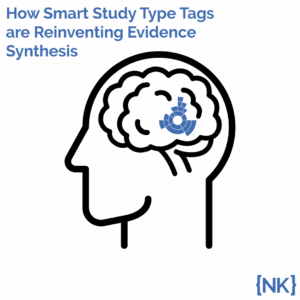
How Smart Study Type Tags Are Reinventing Evidence Synthesis
One of the features of Core Smart Tags is Smart Study Type – this refers to our AI system that automatically categorises the study type
Why Systematic Literature Reviews Matter in HTA
Health Technology Assessment (HTA) decisions are only as strong as the evidence that supports them. That’s why systematic literature reviews (SLRs) are a core requirement across global HTA frameworks. They provide a transparent, reproducible foundation for evaluating the safety, efficacy, and cost-effectiveness of medical interventions.
HTA decisions are only as strong as the evidence that supports them. Whether assessing a pharmaceutical, biologic, medical device, diagnostic, or digital therapeutic, HTA bodies require a comprehensive understanding of how an intervention performs in the real world and how it compares to current standards. While internal company data such as preclinical studies, early-phase trials, or proprietary models can supplement the submission, SLRs form the foundation. They ensure that the full landscape of publicly available evidence is rigorously identified, critically appraised, and transparently synthesized to inform objective, data-driven decisions.
Informing Decision-Making
SLRs are the primary method used to synthesize:
By combining reviews across Clinical, Humanistic, and Economic endpoints, HTA dossiers provide the evidence necessary to compare therapies to existing standards of care and therapeutic alternatives. This evidence feeds directly into comparative effectiveness analyses, economic modeling, and ultimately, pricing and reimbursement decisions. Without a robust SLR, the entire HTA submission would lack the foundational evidence on which reimbursement decisions are based.
Global Requirements
Across jurisdictions, the need for rigorous, protocol-driven reviews is consistent. In the U.S., the AMCP Dossier requires thorough documentation of both clinical and economic evidence. The UK’s NICE mandates predefined protocols, dual screening, and transparent synthesis as part of its Single Technology Appraisal process. Under the EU HTA Regulation, the Joint Clinical Assessment (JCA) now enforces standardized, high-quality SLRs to enable cross-country collaboration in establishing the evidence supporting country-level decision-making.These are only some of the larger bodies, an overview of all HTA processes can be found here.
What Makes an SLR HTA-Ready
It’s not just about collecting studies, it’s about doing so systematically, with documented methods, curated and quality-controlled screening and extraction steps, and traceability from search to synthesis. HTA bodies expect:
How Nested Knowledge Helps
Nested Knowledge streamlines this entire process. Our platform supports every step of the SLR in an HTA-compliant manner, combining protocol management, AI-assisted screening, dual reviewer workflows, tagging, and data extraction in one centralized system. Our systems are designed to meet the standards of AMCP, NICE, the JCA, and more with flexible use of AI (see our guidance on compliance with AI Statements from NICE and the Canadian Drug Agency, as well as a recent overview of AI-in-HTA guidance). Therefore, if you want to accelerate your HTA-focused SLRs responsibly, try Nested Knowledge, and we’ll help your team synthesize HTA-ready evidence—faster, more transparently, and without compromising on quality.
Yep, you read that right. We started making software for conducting systematic reviews because we like doing systematic reviews. And we bet you do too.
If you do, check out this featured post and come back often! We post all the time about best practices, new software features, and upcoming collaborations (that you can join!).
Better yet, subscribe to our blog, and get each new post straight to your inbox.

One of the features of Core Smart Tags is Smart Study Type – this refers to our AI system that automatically categorises the study type